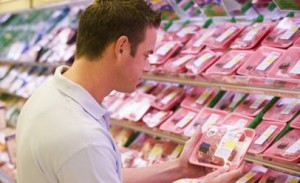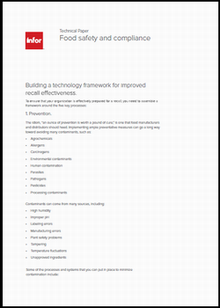 Without necessarily knowing the term “traceability,” consumers have been calling for it in their food system for a long time. The evidence of that comes from the food industry itself, with its increased emphasis on where food came from. Many companies now highlight certain locations or farmers in brand names, commercials, or through packaging and labels.
Without necessarily knowing the term “traceability,” consumers have been calling for it in their food system for a long time. The evidence of that comes from the food industry itself, with its increased emphasis on where food came from. Many companies now highlight certain locations or farmers in brand names, commercials, or through packaging and labels.Food marketing has become more and more about the story of the product and how it got to the shelf at the grocery store or onto the plate at a restaurant.
But now that question has been taken one step further, as consumers wonder whether the information they are given is accurate, or whether the company has the whole picture. In the European Union, consumer confidence in labeling information was shaken during the recent horsemeat scandal, when beef sold at retail and in restaurants was widely found to contain horsemeat.
The ability to follow meat to its source is important not only from an integrity standpoint but from a safety standpoint. In the case of a foodborne illness outbreak, tracing contaminated meat back to its source quickly is key.
What’s happening in the United States to ensure that meat can be traced back through every step of production, and that what’s on the label reflects exactly what’s in the package?
Proactive industry coordination for better traceability
Part of the recent Food Safety Modernization Act, signed into law in 2011, emphasizes more rapid and accurate determination of foodborne illness outbreak sources, a feat that requires accurate traceback information. While FSMA affects the U.S. Food and Drug Administration, and has no regulatory impact on the meat industry (meat is under USDA’s jurisdiction), the yet-to-be-defined traceability requirements in the 2011 law have influenced the meat industry to analyze its own traceback systems. Industry leaders have formed mpXML, a non-profit trade association focused on data tracking along the supply chain.

Earlier this month, mpXML released a “model for critical tracking event traceability.” Board member Douglas Bailey, who also works for USDA’s Agriculture Marketing Service, said the model was “a deliberative document that should be used to educate and inform future discussions about what we should change about traceability here in the U.S.”
“We don’t take a position in the paper on whether this is too burdensome or whether we should do more,” Benson said in an interview with Food Safety News. “This is just an example of what [a traceability system] would look like.”
The mpXML model, which included contributions by employees at Tyson Foods, Safeway, Wegmans, GS1 US, Food Services of America, and others, looked at six different “events” that occur along the supply chain to determine what data collection must be done at each point. Those events include input and output transportation, shipping, receiving, consumption and disposal.
“If you’re a supply chain company, you need to understand if you have one of those events that needs to be documented, and you need to understand what you need to document for that event,” Benson said. “Once you understand that, the next question is how can I efficiently capture it.”
Benson said there are two top priorities for improving traceability in the meat industry. The first is consistency in “global identifiers,” such as avoiding retail and supplier SKUs that do not help in tracing back up the supply chain. The second is focusing on consumption and disposal events.
According mpXML, a consumption event occurs when “a traceable product becomes available to consumers.” A disposal event occurs when “a traceable product is destroyed or discarded or otherwise handled in a manner that the product can no longer be used as a food ingredient or become available to consumers.”
“[Consumption and disposal events] are so poorly understood by health authorities,” Benson said. “The suppliers do a pretty good job of documenting the input and the output. It all goes downhill from there, as it moves through the supply chain.”
The consumer advocate’s point of view
Chris Waldrop, Director of the Food Policy Institute at the Consumer Federation of America, agreed that meat tracing can fall apart as it gets closer to the consumer, especially at the grocery store where butchers are grinding meat to sell by the pound.
“There have been a number of cases of an outbreak of illness, then when FSIS is doing their traceback activities and they get to the retail store, the record keeping is not sufficient for them to be able to determine where the product came from, and when it was ground in the store,” Waldrop said in an interview with Food Safety News. “They kind of hit a dead end.”
There are other areas along the supply chain where following the product back to the next step becomes difficult, most notably from when the cow leaves the feed lot to when it leaves the slaughterhouse as beef.
“It’s not really a strong link between what goes in the plant and what goes out of it,” Waldrop said. “And part of it is because animal ID has been discussed as an animal disease traceability system and not a food safety traceability system.”





